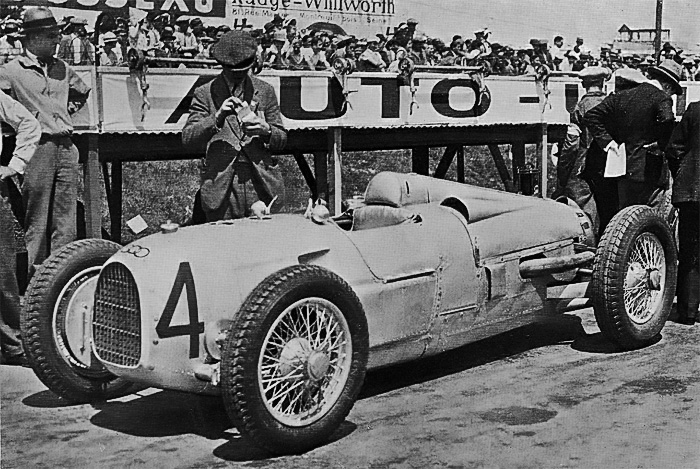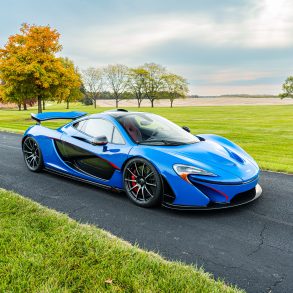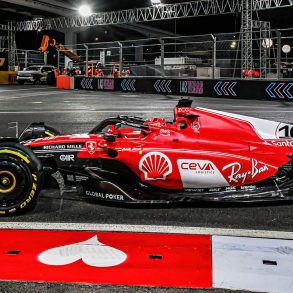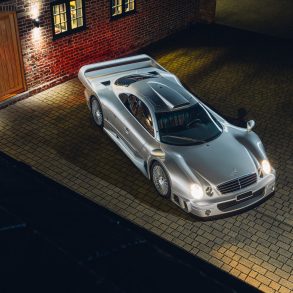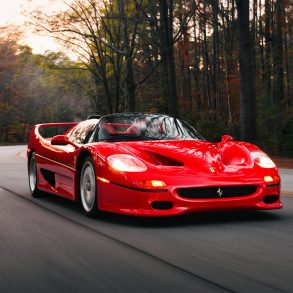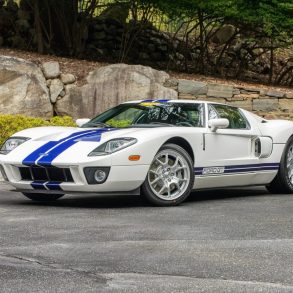1934 French Grand Prix – Giants in the Ring
By Barré Lyndon
Although the French Grand Prix had always been regarded as the most vital race of the year, the entry of the new German cars filled it with greater potentialities than ever before. It was obvious that their drivers intended to do everything that was possible to make their first appearance in Grand Prix racing successful, and it was equally apparent that the Alfa Romeos, Bugattis, and Maseratis would come to the line as fit for the race as experienced men could contrive.
The event was scheduled for July 1, but the Mercedes drivers took two practice cars to the course two weeks beforehand. That the Germans should appear so early was most unusual, and indicated how much importance they attached to the race. Ordinarily, Grand Prix teams do not reach the course until immediately before practice, which normally takes place during three or four days prior to the actual event.

The team was led by Rudolf Caracciola, who had long been recognized as the German champion. He had been racing for twelve years, since his twenty-first birthday, and had won the German Grand Prix five times. With him was Manfred von Brauchitsch. He was twenty-nine years old and, although he lacked Caracciola’s experience, he had already shown his quality. The third driver was Luigi Fagioli, who had gained many successes with Maserati cars and had been Italian champion in 1933. After joining the Mercedes équipe he had done much to school German drivers in high-speed work. The reserve man in the Mercedes team was Ernst Henne, who held the world’s speed record with a motorcycle, and who obviously now intended to follow the steps of Nuvolari, Varzi, and other former racing motorcyclists.
The Mercedes team could not use the whole course for practice because part of it was closed. The circuit for the French Grand Prix is unlike any other. In 1924 a track known as the Linas-Montlhèry autodrome was constructed on the plateau of Saint Eutrope, about sixteen miles southwest of Paris, and a year later a road course was added that incorporated one end of the track itself. It was this section which was closed.
The autodrome is shaped much like a gigantic bowl, a little more than one-and-a-half miles in circumference; two short straights opposite one another make it egg-shaped. The circuit routier, or road circuit, leaves the track at the end of one of these straights, runs out along the summit of the plateau and returns at the far side of the autodrome. The road is designed to include every type of bend and corner, which can be found on a highway, and at the same time to include straights on which cars can achieve real speed.
The road circuit is artificial in the sense that it is not used by ordinary traffic, but this does not lessen its value; that a very short section of the course is formed by part of the track makes very little difference to the event as a road race. The circuit routier tests cars and men as no natural course can do.
When cars leave the track itself, they dive through a narrow opening onto a tarred road which runs straight for nearly a mille, bends slightly, then continues straight for almost another mille. On the left are bushes and trees and, on the right, a narrow grass strip cutting off the return road which at this point runs parallel. After the first fast stretch, the course becomes difficult. The straight ends in a long curving approach to the Lacets de Couard where the road makes three quick bends, then drops very suddenly in a sharp dip before entering a left-hand turn. A short straight is followed by the Bruyères hairpin. One hundred and fifty yards beyond Bruyères is a exceedingly sharp left corner.
Up to this point only three miles have been covered, and within the last of these the course has produced a series of three bends, one hairpin and two abrupt right-angle corners, which is more than sufficient to demand extreme skill from drivers. There now follows a half-mille straight, then the western extremity of the circuit is reached at Les Biscornes, where the road turns back in the direction of the autodrome. This turn is accomplished through a sweeping left bend. Then a long and apparently endless curve to the right, which ends in an abrupt corner, is followed by a short straight and another right-hand corner.
The corner marks approximately the halfway point around the circuit, the severity of which now becomes lessened. The turn is succeeded by a splendid straight more than a mille in length. It switchbacks a little, drops abruptly, and immediately rises again in a long climbing corner around the Virage de la Fôret. The road then bends more gently, only to make an abrupt corner at the Virage du Gendarme, after which it runs parallel with the outward stretch. Near the track it corners left, makes a hairpin turn at the end of another half-mille, then re-enters the autodrome at the side opposite from that at which the road started. From this point cars run around the very steep eastern bank, plunge down to the flat opposite the grandstand, then start out on the circuit routier once more.
The entire setting is very attractive. Here and there are natural banks of colored sand, patches of heather, wild flowers and fine grasses, always with the green of shrubs and trees to form a background. Throughout, the surface is tarred, except on the corners, which are faced with concrete. The total length of the course is 7.8 miles. In 1934 the fastest lap recorded in the French Grand Prix stood at 88.1 mph, set by Tazio Nuvolari. Because the circuit holds a dozen bends of varying severity, eight corners and two hairpin turns, such speed is very high indeed, but the preliminary practice work of the Mercedes drivers suggested that the record would be broken before the race was over.
The Germans were able to run their cars over almost the whole of the road section, and this offered about five-and-a-half miles of the actual course, including the outward and home straights, with all the hazards between. The practice cars were used to ascertain the approximate gasoline consumption of the machines, from which could be judged how much fuel would be required during the race and how many pit stops would be necessary. The Mercedes drivers also made tests to determine the best tires with which to equip their machines. Then Fagioli and von Brauchitsch made an effort to find out how their machines behaved at high speed. They put in several laps, the best being at nearly 84 mph. As this was achieved without benefit of the very fast run around the banking of the track itself and without entering the outward straight at speed, it promised that the Mercedes machines would certainly smash Nuvolari’s record over the actual Grand Prix circuit.
When the practice sessions ended it was evident that the Alfa Romeos, Mercedes, and Auto Unions were all capable of covering the course within about one second of the new record, which showed how evenly matched were the cars. It was unlikely that the record would be smashed again before the race, because the one practice session, which still remained, would be devoted finally to perfecting the machines for the event.
The Mercedes drivers were concerned with their tires, which wore down after ten or twelve laps, and the pit crew made preparations to ensure that any stops for wheel changes during the (ace would be kept as brief as possible. The Auto Unions had some difficulty with fuel feed, but this was rectified during the next day. The ignition of Etancelin’s Maserati functioned badly, and the Bugattis were in difficulties with their spark plugs. The whole of the last practice period was spent in endeavoring to overcome these troubles, so that the evening before the race held promise that all machines would come in excellent trim to the line.
It was quite impossible to guess how the race would run, and the members of each team had their own ideas about their chances for victory. The Frenchmen refused to admit that the Germans were sufficiently superior to win, because the Bugatti drivers-Nuvolari, Dreyfus, and Benoist-all knew the circuit well. Also, the Bugatti équipe had been racing for years, and their machines were the product of accumulated knowledge, while the Mercedes and the Auto Unions were comparatively new and untried.
The Scuderia Ferrari had dominated Grand Prix racing for years and regarded the German machines as the only cars with a definite chance of beating them. Chiron, however, believed that he could take his Alfa Romeo around the circuit in 5 min. flat, 5 seconds faster than the record, if the need arose. His time appeared at least to match the best speed of which the Germans were capable. Also, as the race was over 315 miles-forty laps of the difficult circuit-the new cars might be at a disadvantage; they might not stay the distance.
The Mercedes team thought that the issue of the race lay between themselves and the Auto Unions, although they admitted that the Alfa Romeos were formidable because of Ferrari’s greater experience and the proved reliability of his cars, At the same time, the Auto Union drivers felt that the circuit suited the design of their machines perfectly, and they were obviously intent upon doing their utmost to win. Of the two Maserati cars, little could be said and, although they were fast, both had proved troublesome during practice.
Soon after dawn on the day of the race spectators began to arrive. The weather was intensely hot, and a huge crowd had gathered by the middle of the morning, hours before the start. At the last moment it became known that Hermann had been taken ill, so that only two of the Auto Unions could start. His withdrawal left a field of thirteen cars of a quality and caliber that no event had ever before seen. As the morning wore on the crowds increased until, an hour before the start, eighty thousand spectators were on the course, a record attendance. They paid a record admission of almost eighty thousand dollars.
The flag was due to fall at two o’clock. A quarter of an hour before this time the machines were marshaled to the line-up, every driver being greeted with applause as his name was announced through loudspeakers. The enormous grandstand at one side of the track was completely filled, the nearby enclosures were packed, and all around the circuit spectators were crowded behind fencing set among the bushes at the fringe of the road.
The machines were placed in rows. Achille Varzi, with his scarlet Alfa-Romeo, and Hans Stuck with his white Auto-Union, were in the front rank and these two indicated the real quality of the event. The Italian machine was typical of the existing racing car – low-built, with a blunt radiator to catch a cooling stream of air, a high seated position which gave the driver complete control, and everything about the machine efficiently designed to meet the demands which experience had shown would be made upon it. Against the red bonnet was the yellow shield and the black horse, which formed the insignia of the Scuderia Ferrari, a badge, which had been carried to victory at least once, in every Grand Prix in the calendar.
Standing beside it was the Auto-Union, silvery-white and strange in appearance. Instead of sitting well back in the car, the driver was placed forward, almost within hand-reach of the front wheels. From behind his cockpit a fairing ran down the streamlined tail which shrouded the engine; where the tail ended, a swastika was painted on one side, with the colours of the German national flag on the others, as if it were intended that drivers following the car should have the origin of the machine brought home to them. The radiator was at the front, rounded and cowled, adding to the perfection of the machine’s streamlining, and behind this were openings to allow the escape of air after it had passed through the radiator. The strangely shaped body made the machine futuristic and peculiar in appearance, stressing the fact that it was an altogether new racing car, challenging the older type of machine.
Behind waited Momberger on another Auto-Union with Rudolf Caracciola beside him on a Mercedes, and these cars revealed a second aspect of the race as a fight between representatives of the new-style machine. The Mercedes was a little more orthodox in appearance than the Auto-Union, because its engine was at the front; the cowling for the radiator merged with the streamlining over the front springing, the rear of the cockpit also being faired off into a very short and stumpy tail.
A row of three cars followed, formed by the Bugattis, which Benoist and Nuvolari were driving, and by Chiron’s Alfa-Romeo. The French machines were very low-built, characteristic of the cars which had carried the racing blue of France for so long. Count Trossi’s Alfa-Romeo and a Bugatti, with Dreyfus at the wheel, formed the fourth row, and then came Etancelin and Zehender with their Maseratis and Von Brauchitsch on his Mercedes. Etancelin, as a Frenchman, had painted his car blue, but Zehender’s was a deep red, and these machines were very typical of the older school of motor racing – low-built like the Alfa-Romeos, but longer in appearance because their radiators were carried well forward. The line-up was completed by Fagioli’s white Mercedes, which stood by itself at the back.
These were the fastest road-racing machines that the world had ever known, and they remained silent as the minutes passed. The Mercedes drivers adjusted ear-plugs, intended to damp out the shrill and penetrating whine given off by their superchargers; the rest shifted impatiently against the hot concrete until, one after another, each man slipped down into his cockpit.
Not until barely sixty seconds remained were the engines started up, mechanics using crank-handles, because the rules of the race permitted no other method of rousing the engines. Exhaust notes roared out, rising swiftly to a blast of tremendous sound which echoed across the great track and reached the crowd lining the circuit routier, beyond the narrow exit towards which the machines faced. Mechanics ran from the cars as a starter poised his flag and, during the moments before the flag dropped, Chiron’s Alfa-Romeo began to roll forward as if its driver was impatient and eager to get away. Suddenly the flag fell and, at that, Chiron’s scarlet machine hurled itself away from the line in one magnificent burst of acceleration.
The car shot past Caracciola’s Mercedes before the German driver had moved a yard, then raced by Stuck, snatching the lead almost before the folds of the flag had brushed the concrete. By that time every car was moving, each driver trying to gain ground as the machines converged on the narrow opening ahead. Chiron dived into it, Caracciola bringing his white Mercedes to his tail while Varzi followed, with Dreyfus and Stuck. The rest came behind, and the low walls which bordered the exit from the track caught the sound that the machines made, merging it to a vibrant, echoing scream which faded only as the cars dashed on to the road ahead. Spectators, leaning over the palisades, drew back as the massed machines rushed level, then shielded their faces from the grit and dust which then, kicked behind.
As they cleared the track, Fagioli – who had been last in the line-up – drew his Mercedes to the road-edge, passing the two Maseratis, challenging von Brauchitsch and gaining on the group, which pursued Chiron. The leader was ten yards ahead when he placed his machine for the first long bend, then sent the red Alfa-Romeo through it into the straight that led down to the curves at Couard. Caracciola held him through the turns, while Stuck passed Dreyfus and came up to challenge Varzi for third place. These four went through the hairpin at Bruyères with no distance between them, and only a few yards behind came the rest, struggling together and remaining close in the short straight down to Les Biscornes.
Chiron was still in front when he entered the long straightaway to Fôret corner. Caracciola was with him, his Mercedes howling furiously; Varzi and Stuck were still fighting behind. Von Brauchitsch, Trossi, Dreyfus and Nuvolari were in a bunch a few yards further back, then came the others, with only Momberger’s Auto-Union slowing a little and falling away.
The cars went down the switchback road in streaks of colour that flashed in the hot sunshine: scarlet, silver-white, scarlet again, dead-white, then red and then two flashes of French blue formed by the-Bugattis. These colours represented the nations – Italy, Germany and France. They raced level with the spectators behind the fencing instantly to be gone in a haze of dust, which rapidly blotted them out. All that was left was the falling of grit and small stones which had been kicked high in the air by spinning lyres – that, and the wild roar of exhausts, lessened with increasing distance.
Along that straight, Fagioli gained ground, and at Fôret comer he passed Dreyfus. Beyond the Virage du Gendarme, he overtook Trossi, then passed von Brauchitsch, to challenge Varzi and Stuck by the time that they were near the final comers before the cars ran back to the autodrome.
The crowd in the grandstand heard them approach, and craned to watch the point where the road entered the track on the north side. From between red posts set on yellow-painted walls there came a flash of scarlet. It was Chiron’s car, and he was still leading; from a standing start he had covered the course at 85.3 m.p.h. Hardly was he clear of the walls when the drilling scream of a Mercedes sounded and Caracciola shot into sight, flying after the Alfa-Romeo on to the high banking. Two seconds passed, then Fagioli appeared with his Mercedes, to be followed instantly by Stuck’s Auto-Union, which came from the opening like a torpedo fired from a deck gun.
Chiron had his Italian machine high on the sloping concrete banking by that time, and the car was curving round towards the flat stretch in front of the grandstand. Close behind were the three German cars, then Varzi’s Alfa-Romeo, with von Brauchitsch and Count Trossi. The placing of these machines showed how stern was the challenge to the supremacy of the Scuderia Ferrari. Chiron certainly held the lead, but there were three German cars very close to him; all were well ahead of the blue Bugatti driven by Dreyfus, who led the remainder of the field – Nuvolari, Zehender, Etancelin, Benoist and Momberger – whose Auto-Union was visibly slowing.
Chiron dived for the narrow exit to the road, and the rest dropped off the banking behind him. All were faster down the outward straight – much faster. Stuck opened out, making an attempt to overtake Fagioli who, in the same moment, began to challenge Caracciola. He caught the German champion at Les Biscornes, and went in front of him during the rush to Fôret turn, travelling with Stuck hard on his tail, also passing Caracciola. In the dash back towards the autodrome, Fagioli and Stuck began to fight for second place; running wheel to wheel for a mille, then the Auto-Union slipped ahead.
When Chiron brought his Alfa-Romeo on to the concrete again, Stuck was no more than half a second behind him; he had picked up two places and had lapped at 89.47 m.p.h. They roared round, with Fagioli third and Caracciola now fourth. As the field appeared, Nuvolari slowed and drew to the side of the track, stopping at his pit. He changed plugs while the rest roared away from him, and when he started in pursuit he had been delayed nearly two minutes.
It was on this third lap that Stuck launched an attack designed to establish the supremacy of his Auto-Union. Chiron held him off until they reached the short straight down to Les Biscornes, and here Stuck passed, taking the lead and drawing away. At Fôret corner, the Auto-Union was two seconds ahead, and at the end of the return straight he had doubled this lead. By the time his white machine raced aslant along the banking of the autodrome he was five seconds in front; he had covered the lap at 90 m.p.h., the highest speed ever set up during a race over the Montlhèry circuit.
When Chiron appeared at the tail of the German machine the crowd in the grandstand roared, urging the Frenchman to greater speed. They wanted a Bugatti to win, but these cars were falling far behind. Chiron was driving an Italian machine, but he remained the most popular of French racing men, so they gave him encouragement, waving him after Stuck. Fagioli and Caracciola were together, one hundred yards behind the Alfa-Romeo, with Varzi and Trossi two seconds further back. They disappeared along the circuit routier, while the rest came round the banking, and now it seemed that Etancelin was finding trouble; his exhaust was giving off excessive smoke, but he continued.
The situation, which had existed at the end of the first lap, had changed. Now a German car was leading, followed by an Italian, two more German, then two Italian cars. The white machines held three of the first four places in the race – but Chiron did not attempt to overtake and regain leadership. Hardly twenty miles had yet been covered, and the Frenchman was satisfied to open up a little, not allowing the German to get far ahead and not overstressing his own machine. He let Stuck make the pace, content to wait until he could see how the Auto-Union withstood the strain.

On the next laps Stuck’s average speed rose to 88.6 m.p.h., to 88.8 m.p.h., and then to 88.9 m.p.h. He was working desperately to shake off the Alfa-Romeo, but Chiron remained with him, and even closed the distance between them a little. At the end of the eighth lap the Frenchman was less than a hundred and fifty yards behind, while Fagioli was out-distanced by nearly a quarter of a mille, with Caracciola another hundred yards further back. Varzi, von Brauchitsch and Count Trossi were struggling together, and the field had fallen well away. It was led by Dreyfus, and more cars were in trouble. Zehender stopped for water and oil. Etancelin checked. Nuvolari again pulled in to change his plugs: he was also in difficulties with his gearbox, and the Bugatti reserve driver – Jean-Pierre Wimille – took over.
The order of the leading cars was Auto-Union, Alfa-Romeo, Mercedes, and at the start of the ninth lap Fagioli was signaled to go faster and carry a challenge to the machines ahead. On this lap, too, Chiron decided that he had the measure of the Auto-Union. He opened out and gained steadily upon Stuck while, behind him, Fagioli lapped at 90.6 m.p.h. closing in but remaining third.
The tactics of the drivers had entered another phase. At the outset, Chiron had made the pace, luring the Germans to real speed. When Stuck passed him, Chiron had remained at his tail, forcing the German to a yet higher rate of travel. Now the Mercedes drivers were coming into the fight, afraid that the Auto-Union and the Ferrari machine might get too far ahead. The gaps between the machines narrowed, and when the ninth lap ended, Chiron was within fifty yards of the Auto-Union, the crowd applauding him as he passed the grandstand, obviously intent upon regaining the lead. Fagioli went by, then Caracciola passed and he, too, had closed up; Varzi followed and von Brauchitsch appeared behind him, slowing and running to his pit, where mechanics worked for nearly two and a half minutes on his supercharger; the car restarted, but it had lost much of the stirring roar with which it had begun the race.
On the straight to Fôret corner Chiron caught Stuck. Along the return road he passed the Auto-Union, and the crowd roared when he circled the eastern end of the autodrome, leading. As the two went around the banking, Stuck gradually dropped back while Fagioli appeared behind, rapidly closing the gap between them. As the field followed, Momberger drew into his pit, and he did not restart; the German machine was announced as forming the first retirement of the race.
Answering the pit signal that he had received, Fagioli caught Stuck and passed him, moving at such speed that he set up a new record for the race, covering the circuit at 91.8 m.p.h. When the lap ended he was close upon Chiron while, behind him, both Caracciola and Varzi had also gone in front of Stuck. When the Auto-Union appeared, it ran to where Momberger’s car was being pushed away from the pit; Stuck’s rear tyres were giving out as a result of his fast driving, and he lost time over the wheel change. When he started purposefully into the race again, he had fallen well behind. The Auto-Union had made its challenge, and had been beaten, and now it was the turn of a Mercedes to race for Germany.
Fagioli was gaining fast, and Chiron knew it. He put his foot hard down and the average speed of the race rose yet higher. At the end of the twelfth lap it stood at 89.4 m.p.h. – and still Fagioli closed in. Chiron burst into sight on the autodrome once more, his scarlet machine whipping in a red flash along the concrete, then zooming up the banking, climbing high and pursued so closely by the white Mercedes that there was a gap of no more than fifty yards between them.
In their duel, the two had outdistanced Caracciola, who appeared with Achille Varzi hardly two seconds further in the rear. They were followed by Count Trossi, then by Dreyfus and Stuck -who was driving hard to make up ground, and who came round all but wheel to wheel with Benoist’s blue Bugatti.
Behind these were Zehender, and then Wimille on Nuvolari’s car, and it was while the field was passing that von Brauchitsch appeared, slowing, stopping at the Mercedes pit. His car had been running badly since its last stop; mechanics examined the supercharger again, then the car retired. The crowd watched the Mercedes pushed towards the ‘dead car’ park, to which Momberger’s Auto-Union had gone only two laps before, then attention turned to a double duel, which developed during the thirteenth lap.
Chiron was fighting it out with Fagioli’s Mercedes; behind them, Caracciola on the second Mercedes was struggling with Varzi on his Alfa-Romeo. On the thirteenth lap Chiron lifted the race average to 89.6 m.p.h., while he and Fagioli both covered the course at a speed of 91.8 m.p.h. – equaling the lap record. Each driver was striving to set a pace which would bring trouble to the other machine, and Fagioli’s pursuit was unremitting – but he, lost the fight.
When the two started the fourteenth lap Fagioli gained along the outward straight, then suddenly fell away. Chiron drew further and further ahead until at Les Biscornes he was far in front. He completed the lap at a speed of 91.9 m.p.h., all but equaling the record set up during practice over a cleared course, and he passed the grandstand alone.
Seconds dragged out, and still his challenger did not appear. When the shrill drone of an approaching Mercedes sounded, it was Caracciola who came into view – and Varzi was in front of him. The Ferrari men had won the double duel. Fagioli was at Les Biscornes, standing by his car, which was out of the race; it was reported that a pipe fine to his hydraulic brakes had broken.
With Fagioli’s car disabled, the German attack was broken. Chiron led, and Varzi was second and both Alfa-Romeos were drawing well ahead of Caracciola, who was slowing. When he next appeared he pulled up at his pit, to remain there for ninety seconds while he took on water and fuel and the wheels were changed. He restarted – but he did not come round again. He vanished, just as Fagioli had done. The car stopped at Les Biscornes near its teammate, and it remained there, abandoned.
Von Brauchitsch had retired on the twelfth lap. Fagioli had fallen out on the fourteenth, and on the sixteenth Caracciola had halted finally, so that the whole of the Mercedes team had dropped from the race in the course of six laps. Momberger had retired with his Auto-Union, and of the Germans only Hans Stuck was left, running a full lap and more behind Chiron.
The Scuderia Ferrari had beaten the German machines, and only eight cars were still in the race. Of these, the two leaders – Chiron and Varzi – and Benoist on a Bugatti were travelling steadily and well. The rest had been brought to difficulties through efforts to hold the pace, which had been set.
The gearbox on Trossi’s Alfa-Romeo had developed a defect, which made it possible only to use two speeds; young Moll had taken over the car and was driving well, despite the defect. Zehender’s Maserati lost time through pit stops; the clips holding one rear spring had broken, and mechanics tried to effect a repair. Dreyfus brought his Bugatti in, misfiring badly; when plugs had been changed the mechanics had difficulty in restarting the engine, and the car covered only one lap more before it retired, later to be followed from the track by Wimille’s Bugatti.
Soon afterwards Chiron, now leading handily, dashed up to his pit to change all wheels and replenish in ninety-two seconds. His halt allowed Varzi to take the lead for a lap, then the second Ferrari car checked for similar attention, and Chiron went ahead again. Stuck began to gain ground now, driving hard in the hope that he might t overtake the cars ahead. He began to gain an average of fifteen seconds on each lap, then pulled in to replenish. While he was halted, Moll passed him so that – with the race well beyond half distance -the Scuderia Ferrari held the first three places, and now the drivers began to fight between themselves. Varzi closed on Chiron, and Moll began to overtake Varzi, so that a situation was created similar to that which had existed towards the close of the Tripoli Grand Prix. On the twenty-fourth lap Chiron had a lead of four minutes twenty-one seconds, and Guy Moll was thirteen seconds behind Varzi. Two laps later, Chiron’s lead had been reduced to three minutes fifty-two seconds, while Moll had closed down to eleven seconds with Stuck twenty-seven seconds further back. Behind the first four only Benoist and Zehender were still running, so that but six machines were still on the course. The rest had cracked up under the tremendous pace, the effects of which remained. Benoist brought his Bugatti in for a change of plugs, and mechanics had such difficulty in starting his engine that he spent nearly four minutes at his pit. While he was there, Zehender paused to replenish the radiator of his Maserati, then Stuck pulled in, for mechanics to refuel the car and endeavor to repair a water leak.
As the Auto-Union stood by its pit, there was an atmosphere about the machine and the working men, which suggested that the car’s race was almost run. It made one more lap, then stopped again and, this time, it remained there – withdrawn. The last of the German cars was out of the Grand Prix.
Only seven laps were required to complete the race, when Zehender’s Maserati stopped again. Men laboured over the machine, but the back axle had come adrift from the spring at one side, and they could not repair it. This car also retired.
Four laps from the finish, Chiron was leading and Moll held second place, gained while Varzi checked once more for replenishment. With Varzi third, Benoist’s Bugatti was the only other machine left on the track, running a very long way behind and misfiring badly.
Two laps from the end, Moll stopped at his pit, and Varzi went into second place just before Chiron entered his final lap. He covered ‘he circuit routier for the last time, to win the race at 85.8 m.p.h. Varzi finished three minutes seventeen seconds behind him, and Moll was a little less than a minute further back. Benoist was flagged in when he had four laps still to cover, which meant that only three machines actually finished the full distance of the event.
The race showed that the new German cars were to be feared. Climate event was virtually won during the first hour, but during hour both the Mercedes and the Auto Unions demonstrated speed that easily matched that of the winning car. They fell out because the circuit stressed the machines more than expected; it was a course on which the cars had to work ceaselessly; gearboxes and brakes particularly were put to the test.
At the same time, only minor defects developed in the German cars. They did not fall out because of grave troubles. Usually it takes at least a season of racing activity for a new design to overcome initial defects, yet the German machines had shown no real faults, and this was significant.
Mercedes cars had been racing for over twenty-five years, and it was to be expected that the marque could produce an efficient machine, but the Auto Unions were entirely new and, moreover, were completely revolutionary. Their performance suggested that it would not be long before their engineers mastered the difficulties that had been uncovered in the race.
The outstanding feature of the German cars was that all had independent four-wheel suspension, which made them hold the road far better than cars with normal suspension. Existing Grand Prix cars had become so fast that they approached the limit of safe road speed. With independent suspension, the Germans expected their machines to achieve much higher speeds and still remain on the road. Although they had not been successful at Montlhèry, the race threw a very definite shadow into the future. Both Mercedes and Auto Union had been fairly beaten, but they left the course only to prepare for the next encounter, and the Ferrari drivers realized that next time they were ranged against the German machines the fight would be harder.
1934 French Grand Prix Results
- L. Chiron (Alfa-Romeo) (85.8 mph)
- A. Varzi (Alfa-Romeo)
- G. Moll (Alfa-Romeo)
From Grand Prix (1936) and Great Motor Races edited by Bruce Carter (Weidenfeld & Nicolson, 1960)


